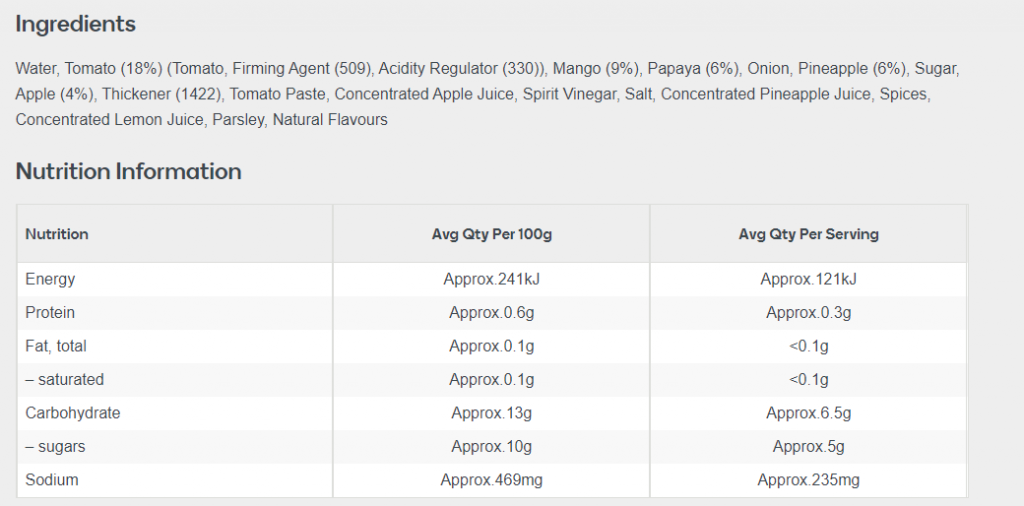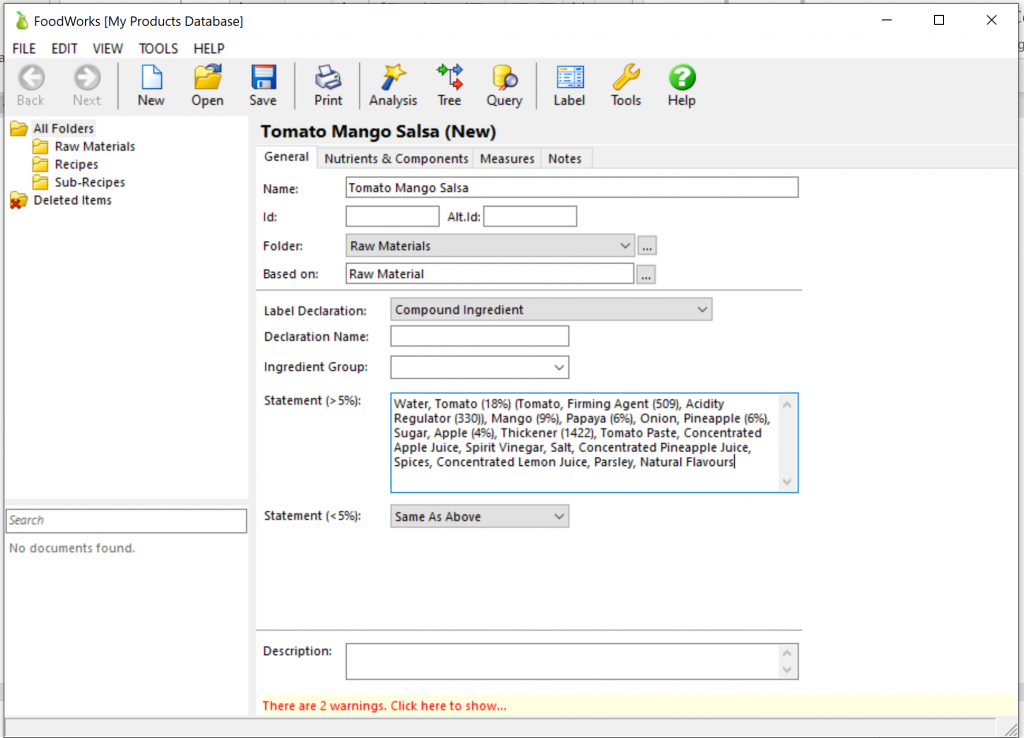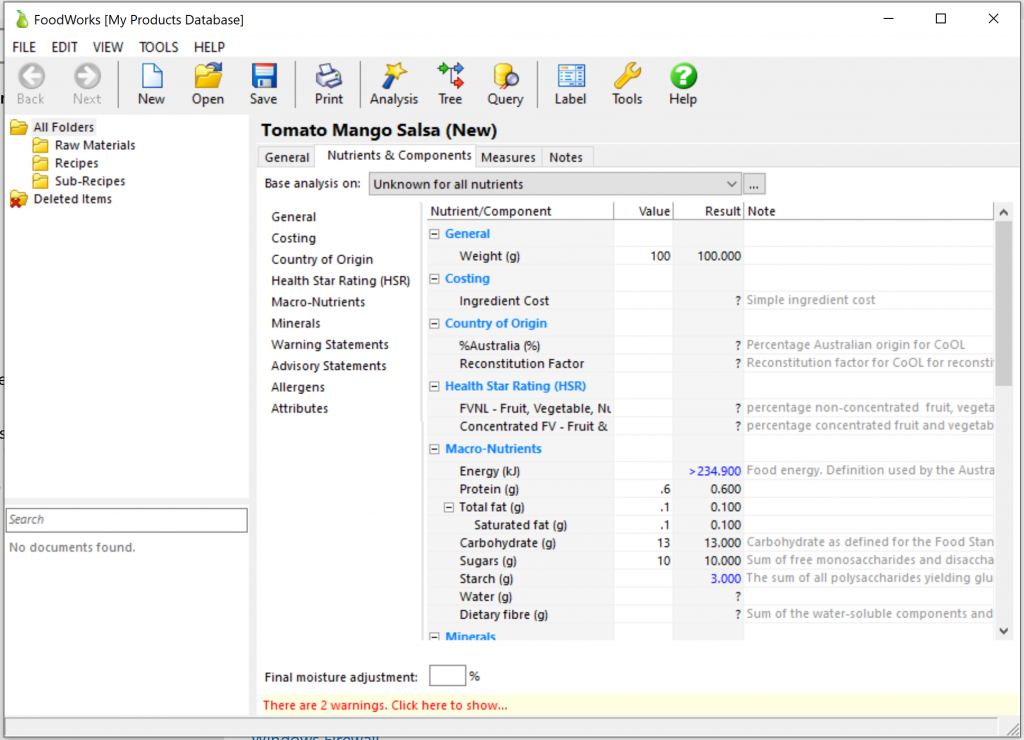Checking nutrient values from a product specification – Best Practice
Are the nutrient numbers supplied for your ingredients correct? Here’s a quick basic check.
In FoodWorks Nutrition Labelling, when you create a raw material using nutrient information from the supplier’s product specification, you can validate that the energy value supplied is reasonable given the macronutrient values supplied – and vice versa.
Here is a worked example of how to do this basic check.
NOTE: This article assumes you are familiar with creating raw materials in FoodWorks. For more information, see Chapter 4 ‘Adding Raw Materials’ in the Introductory Guide for FoodWorks Nutrition Labelling.
Checking the nutrient values supplied for an ingredient – Example
Let’s take this example of an ingredient from a supplier – tomato mango salsa.
Here is an extract of its product specification:
We’ve created the raw material in FoodWorks as below – On the General tab we’ve:
- Given it a name
- Declared it as ‘Compound ingredient’
- Copied and pasted in the ingredient statement from the product specification
Its nutrient values per 100g are supplied as below:
So in FoodWorks, on the Nutrients & Components tab for the raw material, we enter the supplied values for the macronutrients – but NOT FOR ENERGY.
Specifically, we enter the values per 100g for:
- protein
- total fat
- sat fat
- carbohydrate
- sugars
Here they are, typed into FoodWorks in the Value column:
From these macronutrient values, you can see that FoodWorks has calculated the energy, which is shown in the Result column (>234.900kJ).
So now you can compare the supplier’s energy number (241kJ) with the calculated FoodWorks energy number.
Is there a problem with the supplier’s numbers?
There are two basic scenarios that can indicate a problem:
- The supplier’s energy number is higher than FoodWorks
A higher supplied value does not necessarily mean the supplied energy value is wrong. There are other nutrients that potentially contribute to energy that have not been reported – such as dietary fibre, alcohol, sugar alcohol and organic acids. In this example, you might expect that some fibre is contributing to the energy, so 241kJ could be correct.
Here you’d use your professional judgement – if the energy values are significantly different, and there appear to be no other nutrients to account for the discrepancy, you may need to go back to the supplier for clarification.
If you decide to accept the supplier’s energy value, type it in the Value column (and the value will override FoodWorks calculated number).
- The supplier’s energy number is lower than FoodWorks.
A lower supplied value usually means that there is an error in the supplier information.
With any given amounts of macronutrients, there MUST be a certain minimum amount of energy. (For example, 100g of fat contains 3700kJ because 1g of fat has 37kJ as per the FSANZ Food Standards Code.
Once again, you’d use your professional judgement. You may decide that the discrepancy is in an acceptable or expected range of error.
If not, there may be an error either in the values for one or more of the macronutrients or for the energy. You may need to seek clarification from your supplier.
If you decide to accept the supplier’s energy value, type it in the Value column (and the value will override FoodWorks calculated number).
***
Of course if the supplier’s energy number is the same as the FoodWorks number (or within an acceptable range of error), no further investigation is warranted.
Conclusion
You can use FoodWorks to do a basic check of the validity of the nutrient numbers from a supplier’s product specification, thus ultimately helping to assure the accuracy of your own nutrition labelling information.
Related articles
Displaying vitamins and minerals on your product labels
By default, FoodWorks generates nutrition information panels with the mandatory nutrients. What if you wish to highlight additional micronutrients, such as vitamins or minerals?
Read More ›Plain English Allergen Labelling (PEAL) and FoodWorks
Changes are coming for labelling allergens on your food products.
Read More ›Learn the basics of FoodWorks Nutrition Labelling
Keen to get started creating labels for your product recipes? Here’s help.
Read More ›



